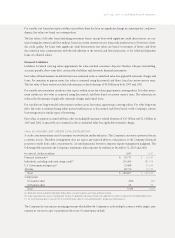American Express 2003 Annual Report Download - page 89
Download and view the complete annual report
Please find page 89 of the 2003 American Express annual report below. You can navigate through the pages in the report by either clicking on the pages listed below, or by using the keyword search tool below to find specific information within the annual report.
Gross realized gains on sales of securities classified as Available-for-Sale, using the specific identification method, were
$359 million, $373 million and $322 million for the years ended December 31, 2003, 2002 and 2001, respectively. Gross
realized losses on sales were ($148 million), ($171 million) and ($574 million) for the same periods. The Company also
recognized losses of ($163 million), ($204 million) and ($428 million) in other-than-temporary impairments on Available-
for-Sale securities for the years ended December 31, 2003, 2002 and 2001, respectively. The 2001 losses include the effect
of the write down and sale of high-yield securities discussed below.
As previously discussed, FIN 46 required the consolidation of a CDO which included below investment grade corporate
debt securities with a fair value of $244 million which are included in the schedules above. These assets are not available
for the general use of the Company as they are for the benefit of CDO debt holders as discussed in Note 1.
There were $80 million, $12 million and $16 million of net gains for the years ended December 31, 2003, 2002 and 2001,
respectively, related to trading securities held at each balance sheet date.
During the first half of 2001, the Company recognized pretax losses of $1.01 billion ($182 million and $826 million in the
first and second quarters, respectively) from the write down and sale of certain high-yield securities. These losses are
included in net investment income on the Consolidated Statements of Income. The second quarter pretax charge of
$826 million is comprised of: $403 million to recognize the impact of higher default rate assumptions on certain structured
investments; $344 million to write down lower-rated securities (most of which were sold in the third quarter of 2001) in
connection with the Company’s decision to lower its risk profile by reducing the level of its high-yield portfolio, allocating
holdings toward stronger credits, and reducing the concentration of exposure to individual companies and industry sec-
tors; and $79 million to write down certain other investments to recognize losses incurred during the second quarter.
Subsequently, during 2001 the Company placed a majority of its rated CDO securities and related accrued interest, as well
as a relatively minor amount of other liquid securities (collectively referred to as transferred assets), having an aggregate book
value of $905 million, into a securitization trust. In return, the Company received $120 million in cash (excluding transac-
tion expenses) relating to sales to unaffiliated investors and retained interests with allocated book amounts aggregating
$785 million. As of December 31, 2003, the retained interests had a carrying value of $694 million, of which $512 million is
considered investment grade. The book amount is determined by allocating the previous carrying value of the transferred
assets between assets sold and the retained interests based on their relative fair values. Fair values are based on the estimated
present value of future cash flows. The retained interests are accounted for in accordance with EITF Issue 99-20, “Recogni-
tion of Interest Income and Impairment on Purchased and Retained Beneficial Interests in Securitized Financial Assets.”
For the year ended December 31, 2001, net investment income was reduced by a $34 million charge ($22 million after-tax)
related to the cumulative effect of the adoption of EITF Issue No. 99-20, as of January 1, 2001. Before this accounting change,
income for the year ended December 31, 2001 was $1.3 billion, basic EPS was $1.01 and diluted EPS was $1.00.
In connection with the spin-off of Lehman Brothers Holdings Inc. (Lehman) in 1994, the Company acquired 928 shares
and Nippon Life Insurance Company acquired 72 shares of Lehman’s redeemable voting preferred stock for a nominal dol-
lar amount. This security entitled its holders to receive an aggregate annual dividend of 50 percent of Lehman’s net income
in excess of $400 million for each of eight years ending in May 2002, with a maximum dividend of $50 million in any one
year. In both years ended December 31, 2002 and 2001, the Company received a pretax dividend of $46 million on these
shares. In the third quarter of 2002, the Company received the final dividend of $23 million under the terms of this secu-
rity based on earnings from Lehman for the six months ended May 31, 2002.
The change in net unrealized securities gains (losses) recognized in other comprehensive income includes two components:
(i) unrealized gains (losses) that arose from changes in market value of securities that were held during the period (holding
gains (losses)), and (ii) gains (losses) that were previously unrealized, but have been recognized in current period net income
due to sales of Available-for-Sale securities (reclassification for realized gains). This reclassification has no effect on total
comprehensive income (loss) or shareholders’ equity.
(p.87_axp_ notes to consolidated financial statements)
























